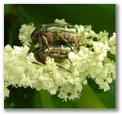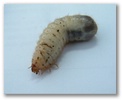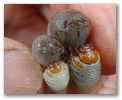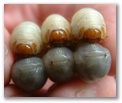Rose chafer Cetonia aurata (Linnaeus, 1758) (Coleoptera: Scarabaeidae: Cetoniinae)
Rose chafers are beautiful iridescent flower chafers, about 15-21 mm long.
The photos shown below try to illustrate its life cycle. They were all taken by myself in Colchester, Essex, CO3 3AT, UK. Colchester being a remarkable hot-spot for rose chafers.
Click on a picture to see a larger view.













Life cycle
In general, the larval stage of Cetonia aurata lasts one year. The larvae pupate around the middle of the summer, the adults overwinter and mate the following spring. Thus, a two year life cycle. [PDF]
Ecology
Flower chafers, C. aurata included, are pollen and nectar feeders - they are pollinators. Their larvae develop on decomposing organic matter: wood, wood chips, compost, leafmould and even manure. Plus in places with well composted soil: plant pots, hanging baskets, trenches, etc. They don't seem to do any damage to the plants.
If you have found any larvae in plant pots, before you do anything rash, please refer to my Gardener's Larva Guide to identify them. Are they friend to foe? Root chafer larvae are very different from flower chafer larvae. Rose chafers are our friends!
Unfortunately, there are some websites that lump the rose chafer Cetonia aurata with the root chafers thus implying that their larvae feed on fresh roots and the adults on fresh leaves. This is utterly wrong. Rose chafers are a beneficial, unlike the root chafers.
Range
In the UK rose chafers are a southern beetle, indeed they seem to like it warm. There is a very good colony in Bristol, for instance. Colchester is an exceptional colony in north-east Essex. For their distribution in Essex, see my paper The Rose Chafer Cetonia aurata L. (Coleoptera: Scarabaeidae: Cetoniinae) in Essex: distribution and some aspects of its ecology.
Perhaps rose chafers are expanding their range. Therefore, all records of adults, and larvae would be very appreciated. Please, contact me if you find any, particularly in Essex, Suffolk and Norfolk!
Contact: Maria Fremlin.
Last updated 8 February 2024
Links
Wikipedia page for Cetonia aurata
Cetonia aurata semiochemical, Pherobase. They do smell very strongly when distressed. Now we know that it probably is anethole.
Rose Chafer – Friend or Foe? Tatnam Organic Patch - An Urban Oasis Wildlife and Organic Garden
References
Chinery, M. (2005) Collins Complete British Insects (Collins).
Davidson, G., Fremlin, M. & Lindsell, S. Monitoring a purpose built 'stag beetle container' in High Woods Country Park. Nature in North-East Essex 2020, 157-163. [PDF]
Englund, R. (1993) Movement patterns of Cetonia beetles (Scarabaeidae) among flowering Viburnum opulus (Caprifoliaceae). Oecologia 94:295-302.
Fremlin, M. (2008) Know Your Chafers, Nature in North-East Essex, 40-45. [PDF]
Fremlin, M. (2018) The Rose Chafer Cetonia aurata L. (Coleoptera: Scarabaeidae:Cetoniinae) in Essex: distribution and some aspects of its ecology. Essex Naturalist (New Series) 35: 167-178. [PDF]
Fremlin, M. (2020) Post-eclosion behaviour in the rose
chafer Cetonia aurata (Coleoptera: Scarabaeidae: Cetoniinae). Entomologische Berichten 80 (6): 202-225. [PDF]
Jessop, L. (1987) Dung Beetles and Chafers (Scarabaeoidea), 2nd ed.
Karolyi, F., Gorb, S.N. & Krenn, H.W. (2009) Trapping pollen by the moist mouth: structure and function of the mouthparts in the flower visiting Cetonia aurata (Scarabeidae, Coleoptera). Arthropod-Plant Interactions 3:1-8.
Micó, E. and GALANTE, E. (2003) Biology and New Larval Descriptions for Three Cetoniine Beetles (Coleoptera: Scarabaeidae: Cetoniinae: Cetoniini: Cetoniina, Leucocelina). Ann. Entomol. Soc. Am. 96(2): 95-106.
Micó. E. and GALANTE, E. (2003) Larval morphology and biology of four Netocia & Potosia species (Coleoptera: Cetoniidae: Cetoniinae). Eur. J. Entomol. 100: 131-142.
Micó, E., Juárez, M., Sánchez, A. & Galante, E. (2011) Action of the saproxylic scarab larva Cetonia aurataeformis (Coleoptera: Scarabaeoidea: Cetoniidae) on woody substrates. Journal of Natural History, 45:41-42, 2527-2542.
Tashiro, H. (1990) Insecta: Coleoptera, Scarabaeida Larvae, Soil Biology Guide, Edited by Daniel L. Dindal.